
HMAS Sydney (1948)
 RAN Light Fleet Aircraft Carrier (1948-76)
RAN Light Fleet Aircraft Carrier (1948-76)
Australia Day !
HMAS Sydney (R17/A214/P214/L134) was the former HMS Terrible (1944), a Majestic-class “light aircraft carrier”, sold in 1947 and completed, then commissioned into the RAN as HMS Sydney, 3rd of the name, in 1948. She was the first RAN carrier, one of three operated during the cold war, and flagship until the 1960s. Her carrer until 1973 included the Korean War, use as a training vessel when arrived in 1955 HMAS Melbourne, in reserve in 1958 but reactivated as fast troop transport from 1962, operating for Malaysia and from 1965, made one of 25 tours of duty in Vietnam until 1972 (“Vung Tau Ferry”).
Genesis: The RAN two-carriers fleet (1948-1973)
Background of HMAS Sydney and Melbourne
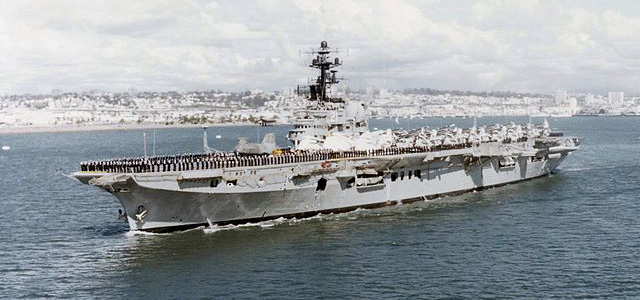
HMS Melbourne in San Diego. Both career would make significant careers and saw combat in Korea and Vietnam.
In 1944, the Australian government suggested that Australian personnel could replace British crews in high demand with the increase in size of the Royal Navy, notably to man one aircraft carrier, two cruisers and six destroyers. The Admiralty agreed to schedule one of its a Colossus-class Light Fleet carrier as a perfect candidate when completed. At first, it selected HMS Venerable, not to serve for the RN with an aussie crew, but directly under RAN supervisions, as gift for its war effort, or on loan. Australia from made a full review review of manpower requirements and recoignised the scale of war effort in all branches, making sure to “reserve” the personnel needed.
By mid-1945, the RAN came back with its proposal, but in between the surrender of Germany had the Royal Navy drastically reduced. All vessels engaged on the Atlantic were now to be disposed off and the freed crews were felt largely enough to continue the war in the Pacific. There was no more emergency. The Royal Australian Navy staff then offered to purchase one of the new Colossus-class, HMS Ocean, but in June PM John Curtin’s government decided against. In July, after a short interregnum of PM Francis Forde, Ben Chifley revised again this proposal.
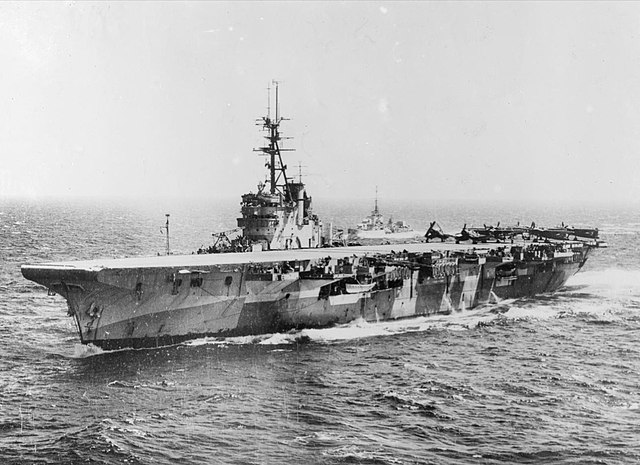
HMS Glory, Pacific, August 1945. All but four of the many carriers of the 1942 programme missed WW2. HMS Terrible, second of the improved Majestic class, was one of these.
The war ended without resolution or participation of a RAN carrier to the war effort. Post-war cirumstances led to a review of RAN needs in a new geopolitical context, which was still fluid in 1946. The RAN specified its plans to acquire three aircraft carriers to form corresponding task forces (One for the Southern waters, one for the Indian Ocean, one for the South Pacific) at the heart of its new fleet. However postwar funding restrictions had it reduced to two, for the north and east coast’s fleets. The staff came back to the same idea of acquiring two Majestic-class ships, with now the certitude their cost would be inferior due to those being now surplus to requirement for the RN.
They selected HMS Terrible (as Sydney) and later the lead ship HMS Majestic, upgraded for jet operations (recomm. 1955) as HMAS Melbourne. In between HMS Vengeance was loaned (from 1952) until Melbourne was fully converted and commissioned, thus, starting its two-carrier fleet’s training and exercizes.
Origin: 1942 Design Light Fleet Carrier
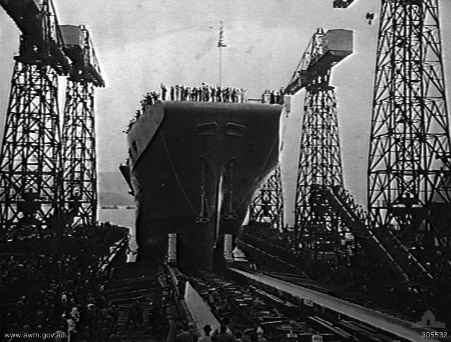 HMAS Sydney was one of the six Majestic-class light fleet carriers, actually a modified Colossus with improvements for the flight deck design, and roomier, among others. The Colossus “superclass” (including the following Centaur) were all seen as “disposable”, civilian yard-built, simplified, unprotected vessels, which were to be and scrapped after WW2 or after just three years of service. But instead, their low price compared to standard fleet carriers, the fact they would be soon surplus to requirement meant the British government would soon have many of these placed on reserve. The new labor government fiercely opposed the RN’s demands for ten task forces and wanted these lower value carriers to be sold or scrapped and focus on the modernization of former fleet carriers as well as completing the ones started on WW2. Thus started a wave of international purchase with some cartoons playing with the idea of all these carriers on liquidation sales. Canada, not Australia, was the first of these “happy customers” acquiring a cheap carrier, HMCS Magnificent.
HMAS Sydney was one of the six Majestic-class light fleet carriers, actually a modified Colossus with improvements for the flight deck design, and roomier, among others. The Colossus “superclass” (including the following Centaur) were all seen as “disposable”, civilian yard-built, simplified, unprotected vessels, which were to be and scrapped after WW2 or after just three years of service. But instead, their low price compared to standard fleet carriers, the fact they would be soon surplus to requirement meant the British government would soon have many of these placed on reserve. The new labor government fiercely opposed the RN’s demands for ten task forces and wanted these lower value carriers to be sold or scrapped and focus on the modernization of former fleet carriers as well as completing the ones started on WW2. Thus started a wave of international purchase with some cartoons playing with the idea of all these carriers on liquidation sales. Canada, not Australia, was the first of these “happy customers” acquiring a cheap carrier, HMCS Magnificent.
The Colossus of at large, 1942 “light fleet carriers” were a Vickers project, which already designed the famous Illustrious class armored carriers. The admiralty totally entrusted their design teams to solve the difficult requirements of building an aircraft carrier in civilian yards. This was one of the most complex ship imaginable, but yet, the same yards proved they have been able to ramp up their game considerably. Depending on their size and abilities, they were trusted to built at first the small Flower class corvettes based on a whaler, the properly military River class ASW frigates which went to serve for decades in the cold war, and it was though that carriers were still manageable as unlike battleships, cruisers or destroyers, mixing protection, various layers or armaments and sensors, a simple unprotected carrier could be undertaken in the large shipbuilders of the nation. Thos accustomed to tankers, freighters and passenger liners. The latter were eager for this anyway as the “cake” was generous: Sixteen were planned by the British admiralty, this was an unprecedented effort for an European Nation.
The eight yards concerned were not all “pure” civilian, but as Harland & Wolff (Irish yard of Titanic fame) sharing the bulk of the order with Vickers-Arsmtrong, as well as Stephen & Sons. The other were of mixed experience, but only acustomed to lighter vessels: Cammell Laird, Swan Hunter, Fairfield, Hawthorne Leslie and later HM Dockyard Devonport for the Majestic ships.
HMS Terrible (R93) was thus built at HM Dockyard Devonport, the second in line for the Majestic class, laid down on 19 April 1943. She was launched on 30 September 1944 and it was uncertain if she would be completed on time to take part in WW2. In fact only four of the Colossus did, pressed into the BPF (British Pacific Fleet) and only seeing little action before the end of the war. The colossal effort imagined in 1942 did not delivered the goods in time, essentially. It was attributed to completion delays due to frequent design revisions notabkt to cope with late-war aicraft design, but this was a short-sighted luxury as they contributed little to the BPF efforts in the end.
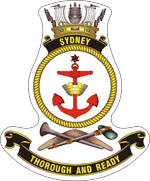 Part of their original motivation has been indeed to reinforce the presence of the Royal Navy in the Pacific, to regain notably some unfluence lost postwar. This was in part a political decision. Alas, this “emergency” ironically has all these disposable ships making a substantial and in the end, profitable carrier postwar, enabling that new capacity to many nations for the first time, not only the commonwealth but France and the Netherlands, and also South America, India, jumped on the bandwagon. These carriers saw most of the cold war and proved perfectly capable to be modernized, but sure, they had their limitations and were mocked by the USN, which made sure to always demonstrate the free world they were the only ones with “true” aircraft carriers. Jet use was made difficult and only the smallest ones (like a A4 Skyhawk, an inspired move from Douglas) and helicopters would still “fit the bill” ffor auxiliary purposes such as ASW and amphibious assault in the 1980s.
Part of their original motivation has been indeed to reinforce the presence of the Royal Navy in the Pacific, to regain notably some unfluence lost postwar. This was in part a political decision. Alas, this “emergency” ironically has all these disposable ships making a substantial and in the end, profitable carrier postwar, enabling that new capacity to many nations for the first time, not only the commonwealth but France and the Netherlands, and also South America, India, jumped on the bandwagon. These carriers saw most of the cold war and proved perfectly capable to be modernized, but sure, they had their limitations and were mocked by the USN, which made sure to always demonstrate the free world they were the only ones with “true” aircraft carriers. Jet use was made difficult and only the smallest ones (like a A4 Skyhawk, an inspired move from Douglas) and helicopters would still “fit the bill” ffor auxiliary purposes such as ASW and amphibious assault in the 1980s.
Design of HMAS Sydney

Blueprint of the class (here, FS Arromanches)
Hull and general design
HMS Terrible/HMAS Sydney displaced in standard 15,740 tons. Fully loaded, 19,550 tons. The hull measured 630 feet (190 m) between perpendiculars but reached 698 feet (213 m) at the tip of the deck fore and aft. The beam was quite resonable at 80 feet (24 m), so making for a ratio of 1/9.5 or so, still favrourable to speed. The draught of 25 feet (7.6 m) was not enabling them all open waters.
The “standard” crew amounted to 1,100, living in quite cramped condition still, despite effort put into the Majestic design, but it was increased to 1,300 for wartime deployments, making it worse. But this included a reduced armament crew, air group and mechanics. As transport reduced requirements meant this went down to a core of just 544 supplemented by trainees RAN Reserve personal, which came in handy to reduce operational cost overall.
As for protection, added during completion as an afterthought, it consisted of mantlets around aircraft torpedoes warheads rooms, 10mm thick (0.39 in). There were also longitudinal watertight bulkheads covering the machinery spaces, but not much else. It was not improved during her career.
Powerplant
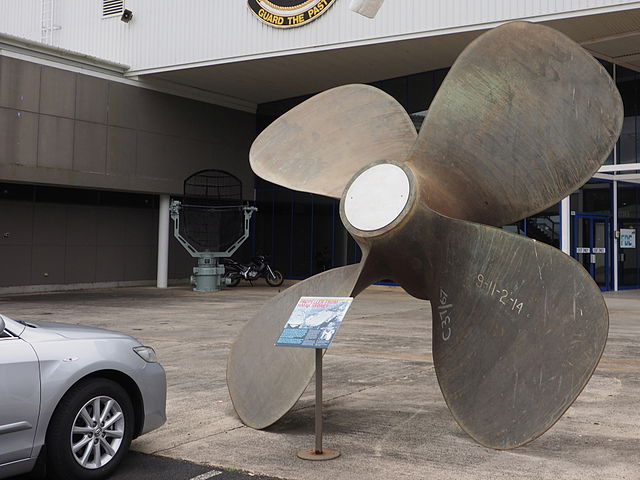
Propeller from HMAS Sydney at the FAA Museum, February 2015
HMAS Sydney came with the standard two shafts driven by Parsons single reduction steam turbines, fed in turn by the same number of Admiralty 3-drum boilers, for a total output of 40,000 shp (30,000 kW) on two propeller shafts, enabling a top speed of 24.8 knots (45.9 km/h; 28.5 mph). Range was 12,000 nautical miles at 14 knots based on 3,480 tons of oil aboard. This configuration was unchanged for the whole of her career, until 1973. Maintenance of this powerplant proved easier than anticipated as skills and maintained throughout.
Armament
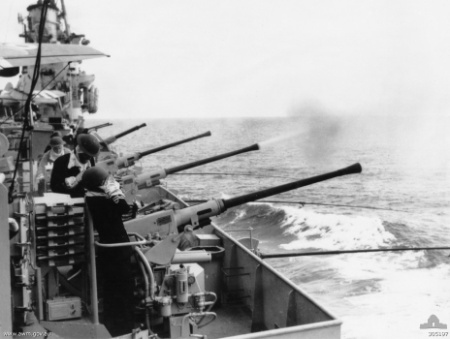
Bofors firing in exercizes, 1950
HMS Sydney was completed with a revision of armament: Instead of the original with six 4-barrelled 2 pdr and 16 × twin 20 mm Oerlikon, war lessons had shown the efficience of the Bofors above both. Thus, she came instead with thirty Bofors 40 mm/60 anti-aircraft guns. Six went in twin mount RP.50 Mk V, replacing the former 2-pdr and the remaining eighteen in single mountings Mk VII. Much later as a troop transport in 1963 she had still her six twin 40mm/60 Bofors and fourteen single, and this went down to just four single Bofors in 1968, more symbolic than efficient.
Still as a troop transport, HMAS Sydney carried vehicles on deck, the hangar was used for troop accommodation. In 1969, she had 6 LCPU installed on davits for rapid troop deployment.
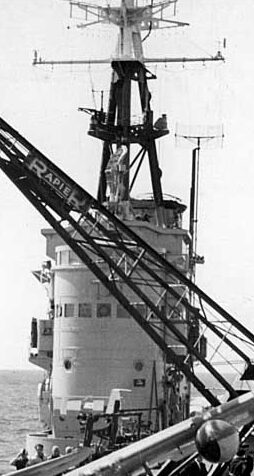
Sensors
The radar suite as completed consisted of two Type 277Q height-finding sets and a Type 293M surface search set, plus a Type 960/281BQ long-range air warning set, and eventually a Type 961 air search set. They stayed the same for all her service, never modernized, despite progresses made in the 1960s.
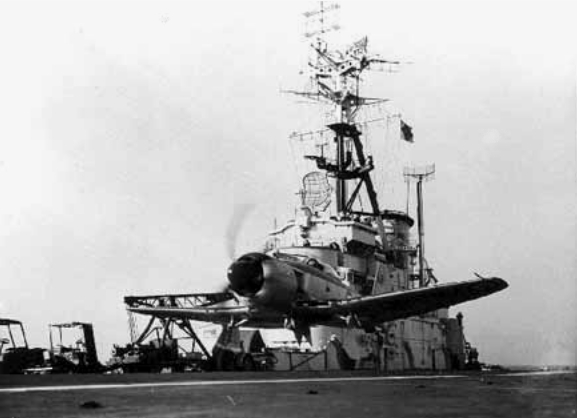
Another view, rear island.
Facilities
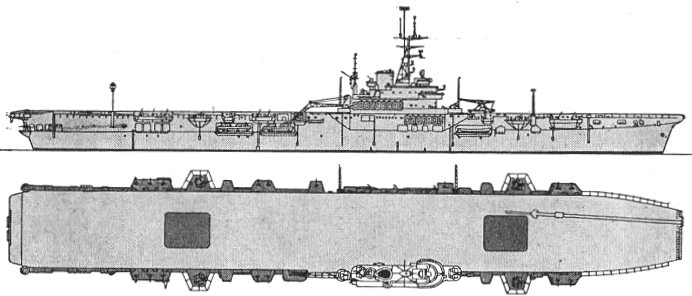
HMAS Sydney in the 1950s, before conversion. src navypedia
Despite the prevision of upgrades to the aircraft lifts and arrester gear to operate heavier aircraft, the RAN envisioned such upgrade, but the emergency made it applied only to HMS Melbourne in the end, with an angled flight deck and mirror landing aid. This upgrade was cancelled on Sydney on ground of budget, and lack of manpower. She was completed as “stock Majestic” with a straight deck, original lifts and arrester cables.
All in all, her deck had a 5,131m² ha or 2,142m² (23,056 Sqm) surface (size 210.3 x 24.4m). Her single space hangar measured 135.6 (445 ft) long for 15.8 wide (51 ft) and 5.3m in height (17 ft) creating a space 11,355m³ (400,000 Cubic ft). Two lifts were installed in the axis, fore and aft of the island, of equal size, 16.5 x 10.4m (54 x 34 ft) and weighting 6.8t (13.600 Ibs). There was a single catapult BH-III forward port, capable of launching a 6.4t (12.800 Ibs) airplane at 122 km/h (75 mph). Aircraft fuel stowage reporesented a total of 303,000 imperial Gallons. Aircraft capacity, with 1945 piston-engine types, reached 52. On the right was installed a board displaying wind conditions.
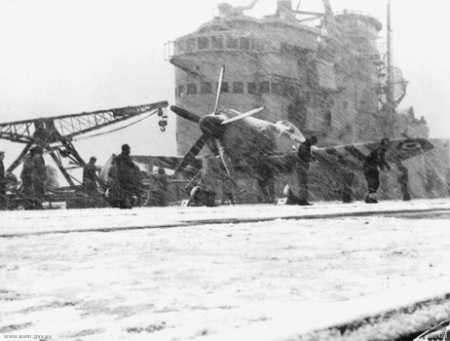
Close view of the island and salvage crane, used notably to operate the Sea Otter, and in the 1960s, various trucks and payloads.
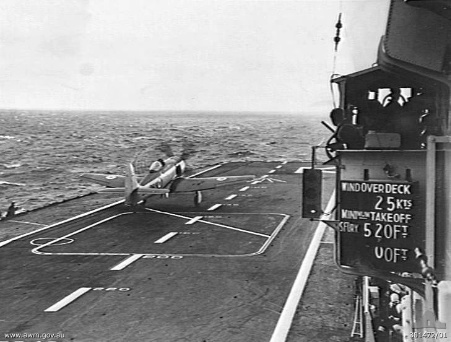
Flight trials: As sea fury taking off with the forward lift behind, closed.
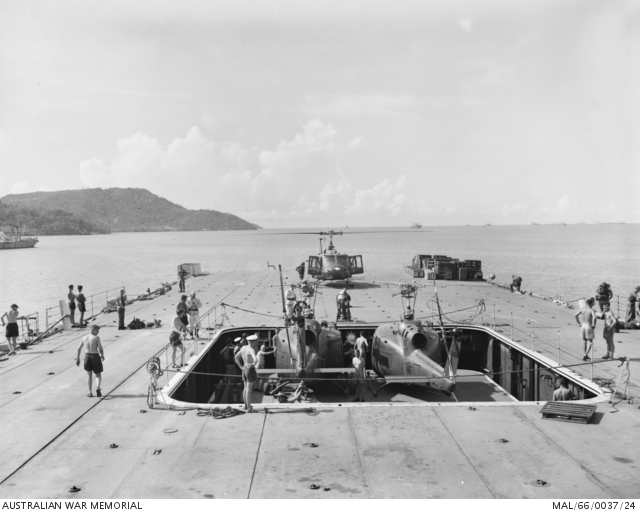
Bell Huey UH-1 helicopters being lifted from the hangar, Vung Tau, June 1966
Air Group
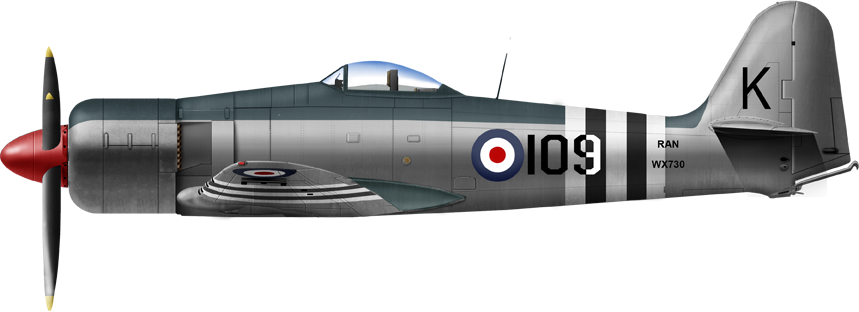
Sea Fury FB Mk.11 of 805 NAS aboard HMAS Sydney, Korea, 1951
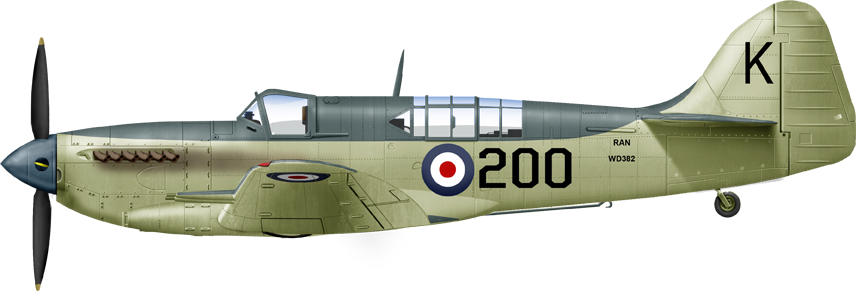
Firefly AS.6, 817 NAS, HMAS Sydney 1952
Early career and Korean war air group: 1950-50
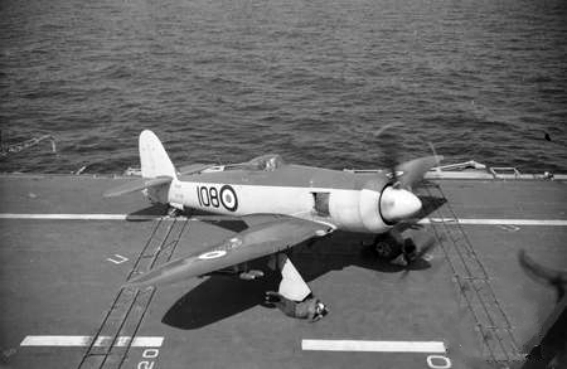
Hawker Sea Fury of 805 Sqn, circa 1951.
HMAS Sydney operated with the RAN Fleet Air Arm’s 20th and 21st Carrier Air Groups (CAGs) assigned alternately, one training on land and the other active aboard. Each CAG comparised two squadrons: 20th CAG: 805 and 816 Squadrons
21th CAG: 808 and 817 Squadrons.
In all, this represented a fraction of her original capacity, twenty-four aircraft, equal number of Hawker Sea Fury fighters and Fairey Firefly attack aircraft, plus two Supermarine Sea Otter amphibians used for SAR (rescue), independently carried as ‘Ship’s Flight’. They were removed as the Korean War started, replaced by a more compact and handy helicopter. At the eight of her engagement in Korea, 21th CAG gained the extra 805 Squadron, so as to reach a total of 38 aicraft aboard for operations.
So in 1950 as the war started she had aboard 12 Sea Fury FB.11 and 12 Firefly AS.4 (22 with adjuction of 805 Sqn.), plus the two Sea Otter.
In 1956 so after the war and at the start of her new schooling duties her air group was reduced to 22 Sea Fury FB.11 and 12 Firefly AS.4. Of course her limited deck, lifts and catapult plus straight deck prevented the use of more modern models.
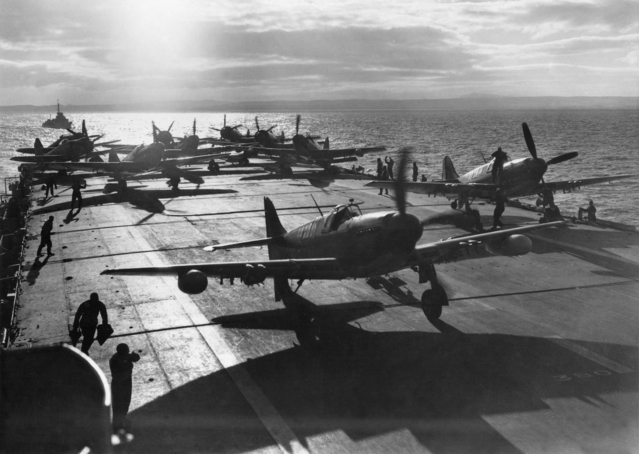
Fireflies in Korea (AWM)
As a transport: 1961-72
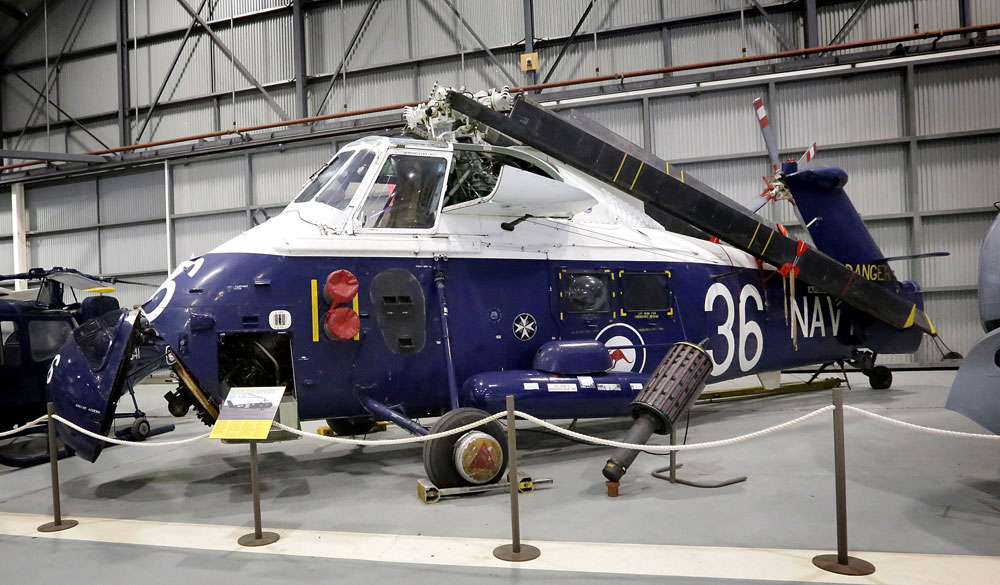
Her air park was drastically changed when converted in 1963 a transport carrier: Her ability to operate aircraft was removed. Arrestor cables and catapult were disembarked. She only carried four Westland Wessex 31A type helicopters, which were occasionally embarked and this flight was sourced from either 725 or 817 Squadron, and were only used for ASW surveillance, patrolling around her.
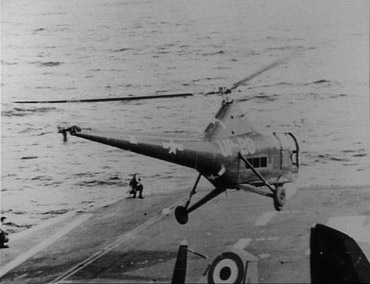
Sikorski S-51 UP-28, used occasionally on Melbourne.
Construction and Modifications
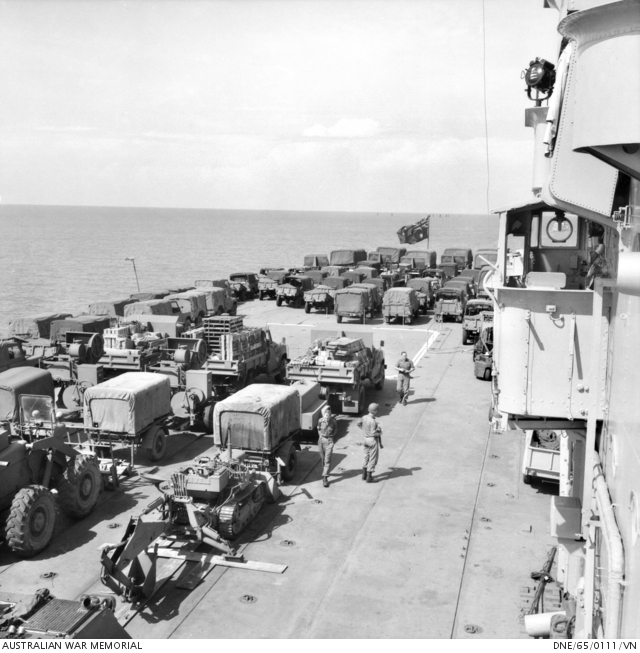
Vehicles on deck of HMAS Sydney en route to Vung Tau, Vietnam.
Originally built in Devonport as HMS Terrible, started on 19 April 1943 and baptised by the Viscountess Astor since she was in a ‘royal dockyard’, owned and operated by the Royal Navy, she was launched on 30 September 1944 by Duncan Sandys wife, and completion was stopped in late 1945 when the Admiralty ordered a suspension of all warship construction. The Australian government’s post-war review (Defence Committee) recommended three carriers/task forces (two active, one in reserve) and then due to budgetary constraints, jsut two in June 1947.
The ones selected were HMS Terrible and Majestic at an estimated cost of AU£2.75 million not comprising equipment and fuel. HMS Terrible was fitted out as a flagship and since she was close to completion when suspended, construction resumed to have her pressed into service without modification. The initial schedule of 24 June 1948 could not be met however due to skilled labour shortages, notably delaying the installation and workout of her boilers, and it shifted to October.
For her commissioning crew, the one from HMAS Hobart (Leander class cruiser) departed from Sydney aboard HMAS Kanimbla in June the same year while RN servicement provided the early workout and yard tests of the ship. HMS Terrible was handed over to the RAN on 16 December 1948. The very same day at noon, she became officially HMAS Sydney. The name choice was guided by the loss of the cruiser in 1941 and raising of £426,000 (Australian) for her replacement.
⚙ Sydney 1948 specifications |
|
| Displacement | 15,740 tons st. 19,550 tons FL (14,380 tons/19,550 tons transport) |
| Dimensions | 630 ft pp, 698 ft oa x 80 ft x 25 ft |
| Propulsion | 2 shafts, 2x Parsons SRG Turbines, 4x Admiralty 3-drum boilers, 40,000 shp (30,000 kW) |
| Speed | 24.8 knots (45.9 km/h; 28.5 mph) |
| Range | Oil 3,480 tons, 12,000 nm at 14 knots |
| Armament | 30 Bofors 40 mm/L60 AA (18×1, 6×2) as completed, see notes |
| Air group | Up to 38: 12 Sea Fury fb.11 fighters, 12-22 Sirefly AS.4, see notes |
| Sensors | 2× 227Q FCS radars, single 293M, 960/281BQ, 961 radars |
| Crew | 1,100 peace, 1,300 wartime, 1,400 ad flagship |
Read More
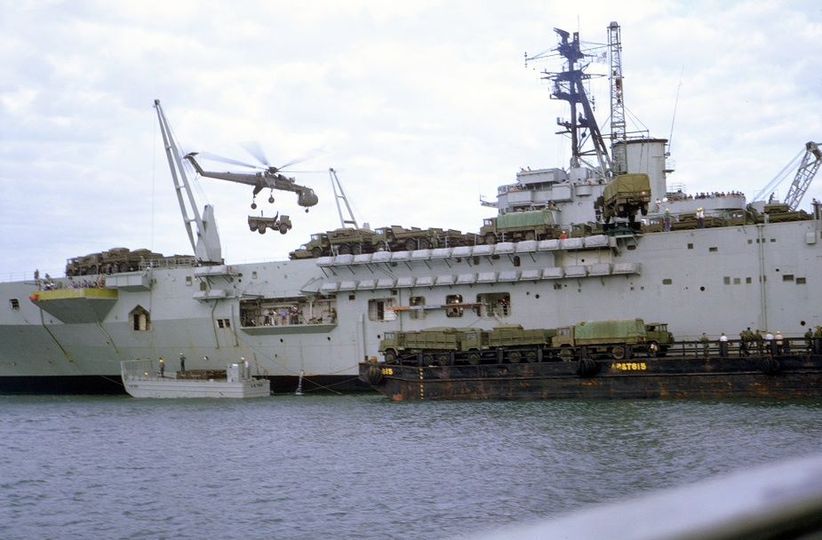
HMAS Sydney as a troop transport in Vietnam, as part of Operation INTERFUSE TWO, 26 octobre 1971. That day she departed Sydney with a cargo consisting of defence aid for Vietnam. During the passage to Vietnam, Sydney was escorted by HMAS Derwent. src aus.gov.org – See also a two views rendition by Russel, the blueprints.com
Books
Australian Naval Aviation Museum (ANAM) (1998). Flying Stations: a story of Australian naval aviation. St Leonards, NSW: Allen & Unwin.
Andrews, Graeme (1973). Fighting Ships of Australia & New Zealand (1973–1974 ed.). Kogarah, NSW: Regency House.
Bastock, John (1975). Australia’s Ships of War. Cremorne, NSW: Angus and Robertson.
Blackman, Raymond, ed. (1968). Jane’s Fleet Guide (1968–69). Jane’s Fleet Guide (71st ed.). Jane’s
Cassells, Vic (2000). The Capital Ships: their battles and their badges. East Roseville, NSW: Simon & Schuster.
Cecil, Michael K. (2009). Mud & Dust: Australian Army Vehicles & Artillery in Vietnam. Chatswood, NSW: New Holland.
Dennis, Peter; Grey, Jeffrey; Morris, Ewan; Prior, Robin (2008). The Oxford Companion to Australian Military History, Oxford University Press.
Donohue, Hector (October 1996). From Empire Defence to the Long Haul: post-war defence policy and its impact on naval force structure planning 1945–1955. Papers in Australian Maritime Affairs (No. 1). Canberra: Sea Power Centre.
Fairfax, Denis (1980). Navy in Vietnam: a record of the Royal Australian Navy in the Vietnam War 1965–1972. Australian Government Publishing Service.
Frame, Tom (2004). No Pleasure Cruise: the story of the Royal Australian Navy. Crows Nest, NSW: Allen & Unwin.
Frame, Tom (1992). Pacific Partners: a history of Australian-American naval relations. Rydalmere, NSW: Hodder & Stoughton.
Frame, Tom (1992). Where fate calls: the HMAS Voyager tragedy. Rydalmere, NSW: Hodder & Stoughton.
Frame, Tom; Baker, Kevin (2000). Mutiny! Naval Insurrections in Australia and New Zealand. St. Leonards, NSW: Allen & Unwin.
Gillett, Ross (1988). Australian and New Zealand Warships since 1946. Brookvale, NSW: Child & Associates.
Gillett, Ross (1977). Warships of Australia. MacDougall, Anthony; Graham, Colin (illustrations). Adelaide, SA: Rigby.
Grey, Jeffrey (1998). Up Top: the Royal Australian Navy and Southeast Asian conflicts, 1955–1972. The Official History of Australia’s Involvement in Southeast Asian Conflicts 1948–1975. St. Leonards, NSW: Allen & Unwin.
Hall, Timothy (1982). HMAS Melbourne. North Sydney, NSW: George Allen & Unwin.
Ham, Paul (2007). Vietnam: the Australian war. Pymble, NSW: HarperCollins.
Hobbs, David (2005). “HMAS Sydney (III): a symbol of Australia’s growing maritime capability”. In Stevens, David; Reeve, John (eds.). The Navy and the Nation: the influence of the Navy on modern Australia. Crows Nest, NSW: Allen & Unwin.
Lind, Lew (1986) [1982]. The Royal Australian Navy: Historic Naval Events Year by Year (2nd ed.). Frenchs Forest, NSW: Reed Books.
MacDougall, Anthony K. (2002) [1991]. Australians at War: a pictorial history (2nd ed.). Noble Park, VIC: The Five Mile Press.
McCaffrie, Jack (2007). “Korea: The first challenge for Australian naval aviation”. In Stevens, David; Reeve, John (eds.). Sea Power ashore and in the air. Ultimo, NSW: Halstead Press.
Nott, Rodney; Payne, Noel (2008) [1994]. The Vung Tau Ferry: HMAS Sydney and Escort Ships (4th ed.). Dural, NSW: Rosenberg.
Pfennigwerth, Ian (2008). Tiger Territory: The untold story of the Royal Australian Navy in Southeast Asia from 1948 to 1971. Kenthurst, NSW: Rosenberg.
Stevens, David, ed. (2001). The Royal Australian Navy. The Australian Centenary History of Defence (vol III). South Melbourne, VIC: Oxford University Press.
Cooper, Alastair. “The Korean War Era” and “The Era of Forward Defence”. The Royal Australian Navy.
Jones, Peter. “Towards Self Reliance”. The Royal Australian Navy.
Wright, Anthony (June 1998), Australian Carrier Decisions: the acquisition of HMA Ships Albatross, Sydney and Melbourne. Papers in Australian Maritime Affairs (No. 4). Canberra: Sea Power Centre.
Links
http://www.navypedia.org/ships/australia/aus_cv_sydney.htm
https://commons.wikimedia.org/wiki/Category:HMAS_Sydney_(R17)
https://www.navy.gov.au/hmas-sydney-iii
Hobbs, David (Winter 2004). “British Commonwealth Carrier Operations in the Korean War”. Air & Space Power Journal.
RAN Ship/Unit Approved Battle Honours PDF
Archive navy.gov.au page
Videos
The “Vung-To Ferry”, footage.
Model Kits
Apart any kit of the original Colossus or Majestic class would do, sdmodelmakers.com released giant kits of each at €1320.51 See also the 1/350 on Facebook.
HMAS Sydney in service
Early service 1949–1951
Post-commission fixes and as Flagship
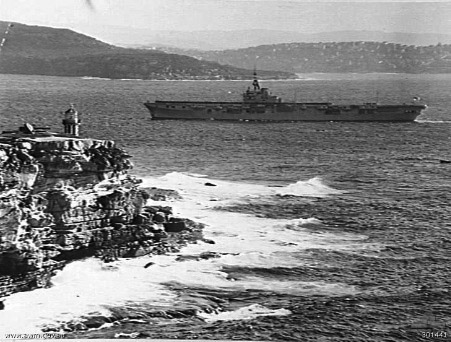
Arrival in Australia, 1949
Commissioned in mid-December 1948, HMAS Sydney did not enter service until 5 February 1949, still work out post-completion. Priot to that on 25 December 1948, while Devonport, the very first model to ever grace her flight deck was an helicopter from USS Columbus, carrying Santa Claus. Quite a symbol of the times… Post-commissioning workup saw also the same month a Mosquito from 771 NAS crashing while giving indication to calibrate her radar suite (bot pilots were killed). Later a RAN pilot also crashed on 17 March 1949 during landing qualifications on HMS Illustrious with his Fairey Firefly, smashing four others in the deck park.

Flight Trials 1949
At last she sailed from Devonport on 12 April 1949, carrying with her an Austrlian crew that lived in Britain for nearly five months. She had the 20th CAG (Air group) aboard, and stopped at Jervis Bay on 25 May to offloaded it, transported HMAS Albatross NAS before proceeding to her namesake city, arriving on 2 June accompanied by a wide fleet of boats and immense crowd cheering on the banks. She became de facto Flagship of the Australian Fleet, transferring the flag from HMAS Australia on 25 August 1949. Later 20th CAG reembarked for a first sortie of exercises wth the fleet in Australian and New Guinea waters, lasting until late November.
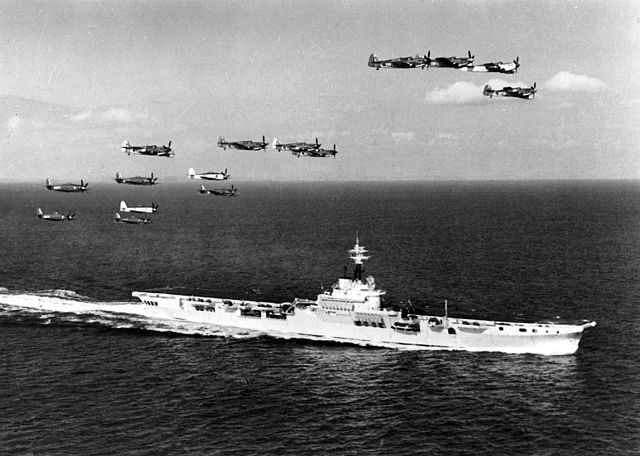
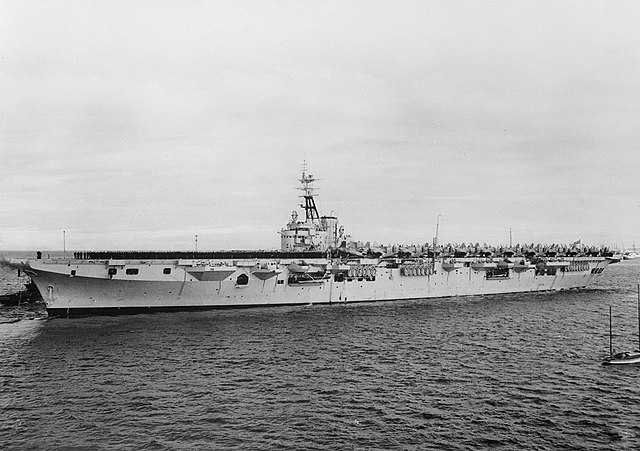
R17 in 1949
These were observed by the whole admiralty and naval staff. After all, this was the first RAN modern task force, US-style. From January to April 1950, training exercises and ports visits went on in south-east Australia and New Zealand. On 7 June 1950 she return for England, this time to embark the 21st CAG, in October, and she was back in December. Already in between there were talks to send her instead in Korean Waters to reliever HMS Theseus which had catapult issues.

On 29 January 1951, HMAS Sydney left the homeland with an eighteen-ship fleet to celebrate the 50th anniversary of the Federation befoire joining a multinational training exercise in SE Australian waters, stopping at Hobart, but also seeing her first blunder, when a Sea Fury accidentally fired four practice rockets into HMNZS Bellona, leater leading to an inquiry which proved that certain signal frequencies transmitted by Sydney’s radio aerials was able to trigger the firing circuits (…). Sydney later earned anyway the “Gloucester Cup” in April 1951, as the most efficient RAN ship for that year. The two CAGs alternated (one on land, the other aboard) in April, May, and another Sea Fury crashed during a rocket-assisted take off, pilot killed.
Korean War
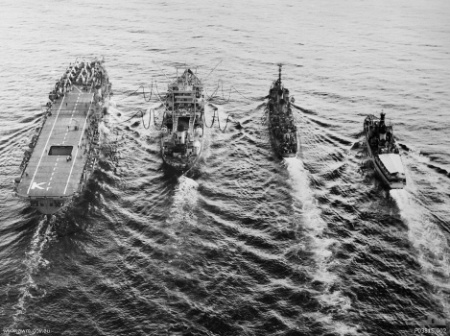
HMAS Sydney and allied ships in Korea
In March 1951, the British First Sea Lord requested HMAS Sydney to assist the RN in Korea, relieving HMS Glory just refitted in Australia, for Commonwealth presence. Thus she departed with her two CAGs, 38-strong on 14 May with the adjunction of 805 NAS into the 21st CAG. The 20th had Fireflies, optimized for ASW (no cannons) so RN aircraft were loaned. After pre-departure exercises, loosing several aircraft with sea and deck crashes she departed for good escorted by HMAS Tobruk on 31 August, making demonstration demonstrations over Rabaul on 6 September during the civil unrest there. Upon arrival, she became the first Commonwealth Task Force seeing wartime service.
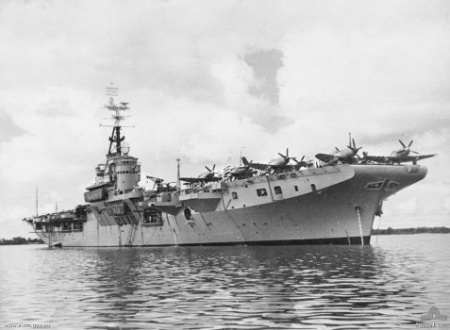
Sydney in 1951
Sydney was attached to the lead local fleet, the US 7th, as part of Task Element (TE) 95.11, operating off the western coast, providing ten-day patrols followed by the first of many resplenishments at Sasebo, Nagasaki or Kure, Hiroshima, replaced either by USS Rendova or USS Badoeng Strait. Air strikes against North Korean targets and supply lines were completed by reconnaissance and bombardment spotting for the fleet on the coast and air and anti-submarine patrols around the fleet. At some point she operated the USN Sikorsky UP28 Dragonfly “Uncle Peter” for SAR/plane guard, first ever helicopter on an Australian warship, which success convinced the RAN to purchase three Bristol Sycamore in complement, first heli-sqn.
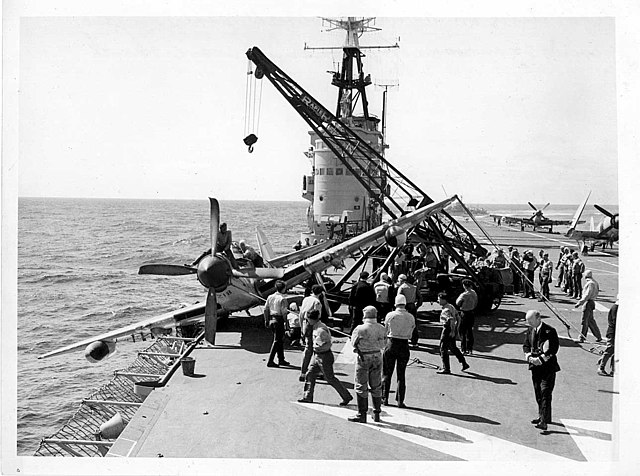
A Damaged sea fury is retired from a preilous position. There were many crashes, most attributed to bad weather. The Firefly proved sturdier and easier than the Fury.
Sydney’s first patrol went on from 4 October, supporting troops at the Han River and venturing on the east coast, for strike missions near Wonsan. On the 11th she flew a record 89 sorties, having 31 aloft that day. After a supply stop to Sasebo she was away to dodge Typhoon Ruth, but too late: She had a A Firefly, 16-foot motor dinghy, and forklift thrown overboard, plus six other aircraft parked destroyed, trying to present her prow or stern to 68 knots wind gusts and giant waves. Her second patrol started on 18 October, with striked over North Korean units and close air support mission on 21 October for the 1st Commonwealth Division.
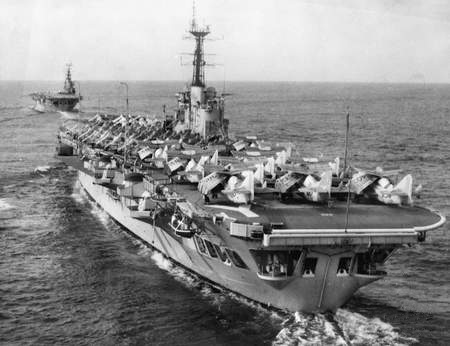
She had her first two losses in combat: Two Sea Furies shot down on 25 October but the pilots parachuted. Another was short down during another five RAN aircraft raid against a railway tunnel, but it was 75 miles (121 km) inland so beyond rescue helicopter range. “Uncle Peter” nevertheless volunteered, armed with with the observeir aboard armed with an Aussie Owen submachine gun, covered by four RAN aircraft. This was a success, the RAN aircrew went home with escorting Fireflies but at extreme fuel limits: “Uncle Peter” was rerouted to Kimpo AB in South Korea, the longest helicopter rescue transit of the war so far. The Sikorsky pilot later was awarded the British Distinguished Service Medal and the USN Cross. Eventually HMAS Sydney was relieved by USS Rendova on 27 October and and went to Kure.
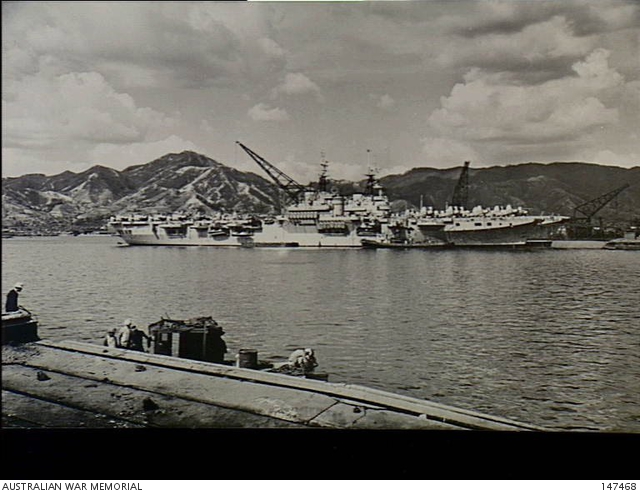
HMAS Sydney repleninishing in Kure
She was back for her third patrol on 5 November, west coast of Korea, escorted by RCAN Athabaskan, Cayuga and Sioux, USS Hanna and Collett. A Sea Fury pilot crashed in action, and operations went on despite foul weather, with a 1000th combat sortie flown on 12 November. On the 18th she was in Sasebo and departed to Hŭngnam with HMAS Tobruk, and HMS Belfast to join TF 95.8 on 20–22 November. There was later an accident while refuelling with a large spill and refuelling rig damage. Strikes went on until she returned to the west coast, marred by snow. By December, TE 95.11 fell under UN Command, and the 5th US AF, and her CAGs were in convoys air escort from Japan.
Her fifth patrol commenced on 7 December adn the next day she had another RAN pilot KiA by flak and Four other damaged. Clearer weather until 14 December allowed more sorties until the 18th. In all, she had 5 airraft destroyed and 25 heavily damaged. Her costliest sortie. Her crew spent Xmas in Kure, replaced by USS Badoeng Strait. She made a sixth patrol over Inchon and convoys returning to Japan.
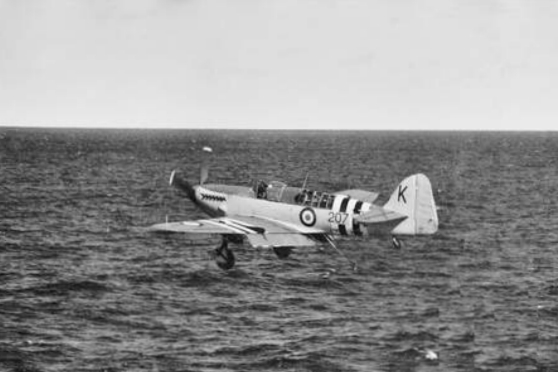
Firefly FR4 817 Sqn off Korea 1951
In 1952, her CAG helped to repel the North Korean invasion Yongho Do. She he had a 3rd pilot lost on 2 January during a CAP. The Fury literrally entered a strange cloud and never emerged with no wreckage found afterwards; complete and unexplained disparition. The carrier’s CAG went on in suport of units fighting in the Cho Do-Sok To area, but snow storms plagued operations. Her 7th and final patrol from 16 January (escort: HMAS Tobruk, HMCS Sioux, USS Hanson, USS Radford) saw little activity due to foul weather and poor coordination with UN forces. Her CAG targeted North Korean supply line infrastructure and water towers. The last day she had most of her deck park literally encased in frozen sea water due to extreme sub-zero temperatures. On 25 January she was relieved by HMS Glory.
Post-Battle Report for 7 Patrols 1950-52

She returned home after 122-days of operations, 42.8 days flying, 11.7 days lost to poor weather but 1,623 sorties, 802 bombs, 6,359 rockets, 269,249 rounds spent. Three pilots KiA, 13 aircraft lost definitely. AA artillery proved the most deadly, but also bad weather. It was assessed that her air group managed nevertheless to damage or destroy an estimated: 66 bridges, 141 wagons and locomotives, crica 2,000 structures, 469 watercraft, 15 artillery pieces and perhaps 3,100 casualties. It was judged “underclaimed” by ground US personal reporting on the results. Many DSCs were awarded, a DSM, ten Mentions, two US Legions of Merit and the Australian Active Service Medal, Korea Medal, UN Service Medal while the carrier earned the battle honour “Korea 1951–52”. Her support was saluted in the press for allowing more independent operations for Australian soldiers in Korea.
Back from Korea, HMAS Sydney ferried Spitfires and Vampires to bases in Southeast Asia and after a refit she embarked the 20th CAG (June 1952) before a round-Australia training cruise. She also stopped at Manus Island, and witnessed at Montebello Islands the first British atomic bomb test (Operation Hurricane) on 3 October 1952. On 25 March she departed for England to assiste to the coronation of Queen Elizabeth II’s naval review on 15 June. She also visited Canada and the US down to the Caribbean, crossed the Panama canal to Hawaii, and was back to New Zealand, arriving in Sydney on 15 August and soon celebrating her 10,000th deck landing while off Pearl Harbor.
Second Korean Deployment (1952–1958)

Winter 1952-53 Operations
She left Fremantle after preparations on 27 October 1953 for Korea, and arrived to support the UN contril of the ceasefire and July 1953 armistice. She stayed there until January 1954, but this was uneventful. Flight operations were limited to patrols along the DMZ. One pilot however died as his Sea Fury crashed into the ocean, another later plus an aircraft handler. She was back to Fremantle on 2 June 1954. Her upgrade like Melbourne was cancelled in 1954 due to budge constraints. Now the new carrier was there, she was prepared instead as a training ship, to provide experience crews to the near-identical Melbourne.
She made her last regular air operation on 22 April 1955 and on 26–29 April a reorganizaton of personal followed. She trained in New Zealand waters in May and was refitted, making her post-fix cruise between Sydney and Adelaide via Melbourne and back to Sydney. She was also visited by Earl Mountbatten of Burma. On 1st May 1956, she was reunited to HMAS Melbourne off Kangaroo Island and both sailed together untin the end of their delivery voyage, via Jervis Bay. On 13 May, she was no longer flagship, Melbourne was. After extra training cruises she was sent with the Far East Strategic Reserve, a SEATO multi-fleet exercise by the end of 1956. She was evaluated in 1957 as a commando carrier, aircraft transport or troopship, and she was in the special reserve on 30 May 1958, surplus to requirements and waiting her fate.
Fast Troop Transport (1958–1965)
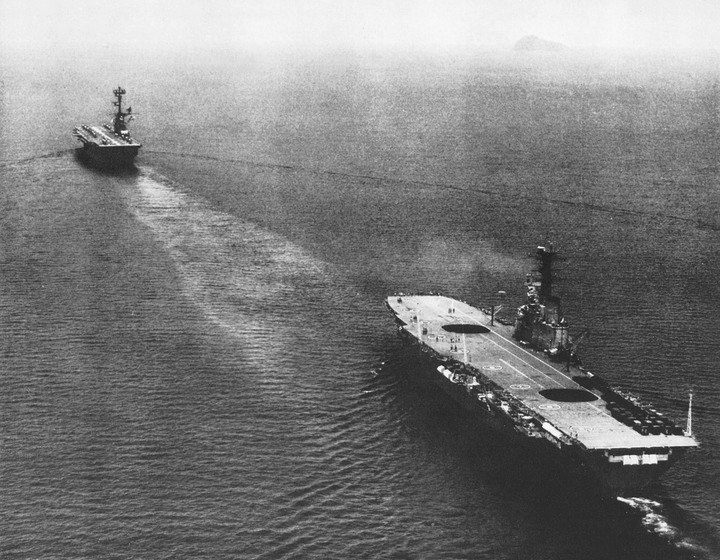
HMAS Sydney and USS Valley Forge in 1964
In 1958 to 1960, Thought to dispose her or reactivate her as a transport saw the latter opinion prevail: She would be converted as such. The admiralty indeed saw a need if a new war broke in the volatile Southeast Asia for rapid deployment of the troops by default of a specialized assault ship. Sealift at a grand scale seemed the best option, including for vehicles. But the cost of convertion and maintenance was hotly debated in parliament. It was the lack of strategic airlift and sealift that eventually sealed the deal.
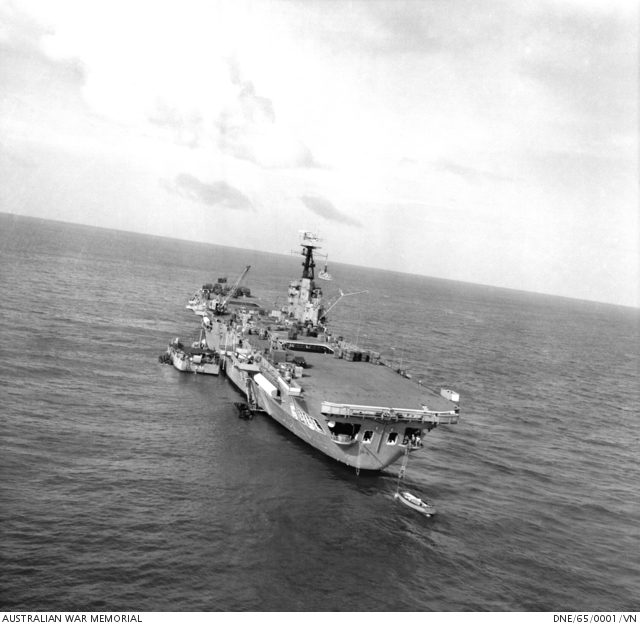
Her convertion as fast troop transport ship in 1961-1962 saw the removal of her aircraft operating equipment and hangar reconfigured between accommodation quarters and new storage areas, armament reduced. No upgrades were made to her radar suites. Recommissioned as a Fast Troop Transport on 7 March 1962 (A214) she was reassigned to the training squadron and from April 1962 she trained Army personnel for the transport and fast disembarkation of troops and materials. Full service started by August 1963, performinf at Hervey Bay in Queensland (Exercise Carbine), and from 27 September to 4 October, the conveyed the Governor-General of Australia (Viscount De L’Isle) on a tour to Lord Howe Islands.
She started a training cruise to northern Queensland with trainee officers and sailors on tour on her whaleboats around Hayman and Hooke Islands and a search party lauched after 12h when they failed to return. Board of Inquiry was held later and court-martialled the captain and several officers for the missing personal.
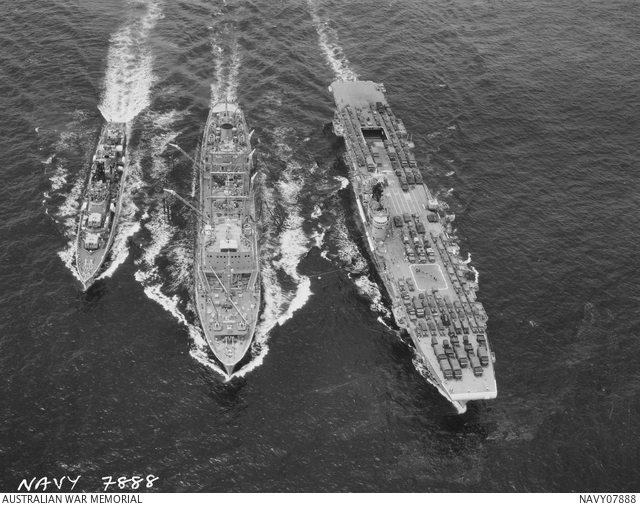
HMAS Duchess and HMAS Sydney refuelled while en route to Vung Tau
Later she made a new overseas deployment as transport, to Southeast Asia in 1964 from late May, loading supplies and munitions for Malaysian forces engaged against Indonesia: 1,245 personnel (7th Field Squadron, 111th Light Anti-aircraft Battery) plus four UH-1 Iroquois helicopters and N5 Squadron RAAF. She departed Garden Island on 24 May and on high alert in New Guinea waters for the operation, meeting HMAS Yarra and Parramatta off the Philippines on 3 June, proceeding to Kota Kinabalu, disambarking and leaving for Singapore to offload 250 tonnes of ammunition. Then Penang, to offload the troops and more ammunitions (16–17). On 23 June she shadowed an Indonesian submarine for 18 hours and proceeded to Fremantle. In 2010 she would be awarded the “Malaysia 1964” award during a veteran reunion.
Vietnam War (1965–1972)
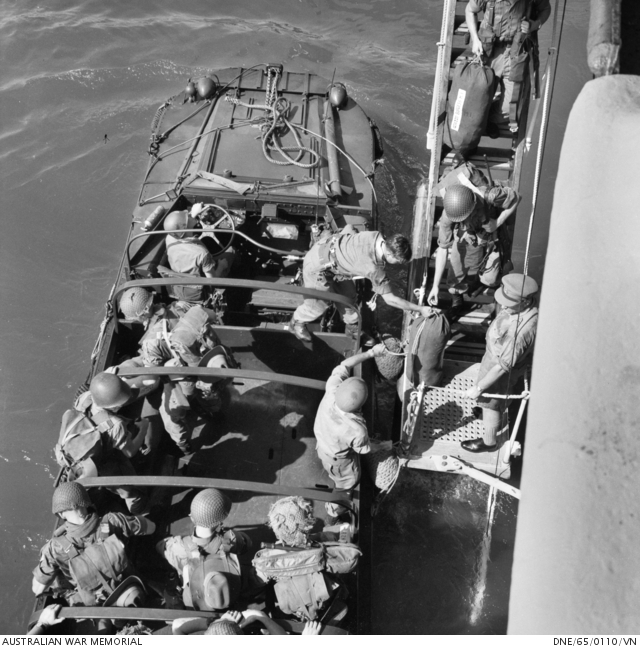
1st RAR soldiers unloaded into DUKWs at Vung Tau
As a troop carrier she made no less than 25 voyages to South Vietnam, supporting the 1st Australian Task Force (with HMAS Mebourne as flagship) from May 1965 and until November 1972, keeping her busy for the remainder of her carrer. She made the first with the civilian vessels Jeparit and Boonaroo and since the Austrlian base was located at Vũng Tàu she soon earned the “Vung Tau Ferry” moniker. She alternated these with her usual training ship duties, carrying up to 30 midshipmen and 200 trainees over cruises in Oceanian waters.
Operating Mode
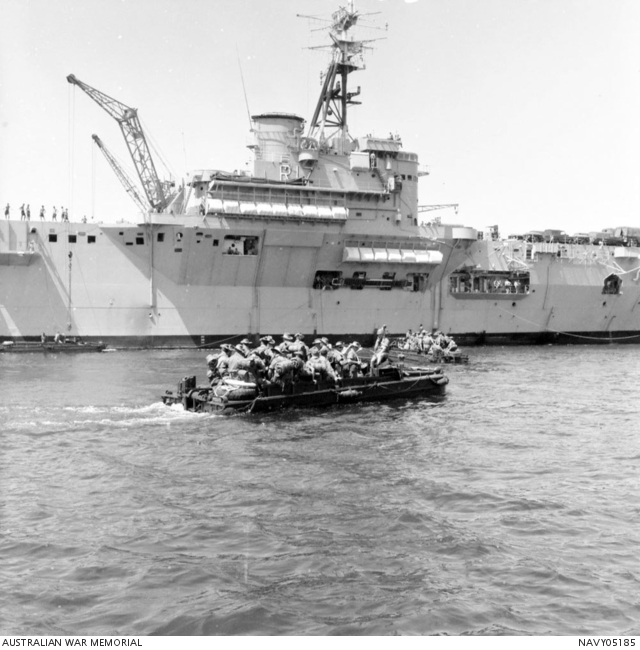
Australian soldiers ferried in small crafts to guard Sabah (AWM)
Typically she would carry 450 soldiers of the RAR (Regiment) and battalion—level equipment and vehicles, trucks, jeeps, mortars and artillery of various use. Soldiers were accommodated in the sailors mess decks, sailors in the noisy hangar, Vehicles secured on the flight deck, cargo packed onto pallets in the hangar and flight deck. Saigon was the initial planned stop, but this was denied by the CO John Crabb, due to the fear of mines, Vũng Tàu being selected as safer. When the ship arrived at anchor, soldiers and equipment were conveyed to shore by helicopters but also landing craft and barges, the original onboard crane fitted to handle seaplanes being used daily. This was a several days process, and each night, she would drop anchor further away from the shore, in deeper waters for safety. After her 1968 refit, she would have three new Favelle Favco-type cargo cranes installed, plus six LCMs on davits (16 built in all) to ease operations and permanently attached troop-carrying helicopters, so a single day was needed afterwards. Chinese submarines could still ambush her while en route, and close to the shore, Viet Cong swimmers could intervene with limpet mines so she always had an escort and small boats patrols during the operation. Divers also regularly inspected her hull, propellers, and anchor chain. She had a park of four Westland Wessex for ASW (817 Sqn).
Detailed operations
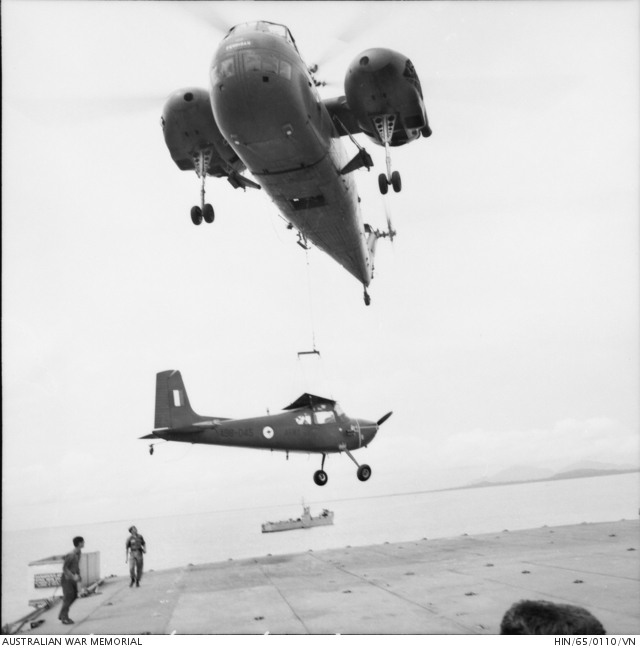
A CH-37 lifts a Cessna 180 from her deck
After her May 1965 refit at Garden Island, she departed on the 23th under strict media silence.
-Fir this 1st voyage, she carried the 1st Battalion RAR and Prince of Wales’s Light Horse armoured regiment for support, logistics unit and for concession to the ban, a group of journalists to cover the operation. She stayed in Vũng Tàu on 8-11 June, back to Fremantle on 26 June, escorted by HMAS Duchess, but also Parramatta, Melbourne, and Vampire part-way.
-Her second voyage was on 14 September with Duchess and Vendetta. However while back she stopped in Subic Bay underway to home port Sydney. She reaned the Gloucester Cup for efficience for 1966.
-The 3rd voyage started on 24 April 1966, with the 5 and 6 RAR aboard, escorted by HMAS Vampire, Yarra, and Melbourne. She disembarked troops and personal on 4-6 May while Melbourne was detached for air support in Vietnam. Her escort went to Hong Kong but she was back to Sydney on 18 May.
-4th voyage: On the 25th, she departed with the rest of 5-6 RAR and No. 9 Sqn RAAF, escorted by Yarra, Melbourne, Derwent, and Vendetta. Underway back she also assisted USS Tiru running aground on Frederick Reef. On 1 March 1967 her ensign was changed with the Australian White, but still flew also the old one.
-For the 5th voyage, she carried the 7 RAR with Westland Wessex aboard due to the fear of Chinese subs.
-She left Singapore for her 6th voyage, this time with the 5 RAR aboard, to carry them back home on 12 May 1967.
-Her 7th started on 19 May from Brisbane with 2 RAR and a 1st Battalion RZNR company for their first deployment in Vietnam, escorted by HMAS Stuart. Operations went quick with her park of Chinook helicopters.

Huey helicopter brought on deck via the lift, Vung Tau.
-Her 8th voyage was with 3 RAR from Adelaide.
-Her 9th voyage started on 17 January 1968, meetinh HMAS Stuart off Singapore and stopping at Sattahip (Thailand) on 31 January en route to Vũng Tàu.
-Her 10th voyage (27 March-26 April) was with with 1 RAR, escort HMAS Parramatta.
-Her 11th voyage with HMAS Anzac escorting (21 May-13 June) was with 4 RAR. It was followed by an extensive refit to ease operations between cranes and LCMs from davits. In September-October she was flagship again for the amphibious warfare exercise “Coral Sands”, followed by a training cruise to New Zealand.
-Her 12th voyage with 9 RAR (13-28 November) escorted by HMAS Duchess. She returned with 3 RAR and a damaged de Havilland Caribou. In 1969 she earned the new pennant P214 according to US-NATO-SEATO regulations.
-Her 13th voyage (8 February 1969-25 February) with 5 RAR, escorted by HMAS Derwent saw her visiting when back New Zealand and Fiji.
-Her 14th voyage was with 6 RAR, returning with 4 RAR (8-30 May) escorted by HMAS Vampire.
-Her 15th (17 November-5 Nov.) was with HMAS Duchess and 8 RAR aboard, returning with 9 RAR to Fremantle
-The 16th (16 February-5 March 1970) wuth the 7 TAR escorted by HMAS Yarra. However n 16 April, she took part in a 45 vessels review for the Australian Bicentenary in Sydney. She also visited Portland, Victoria for the Bicentenary Royal Tour of Queen Elizabeth II and the Duke of Edinburgh.
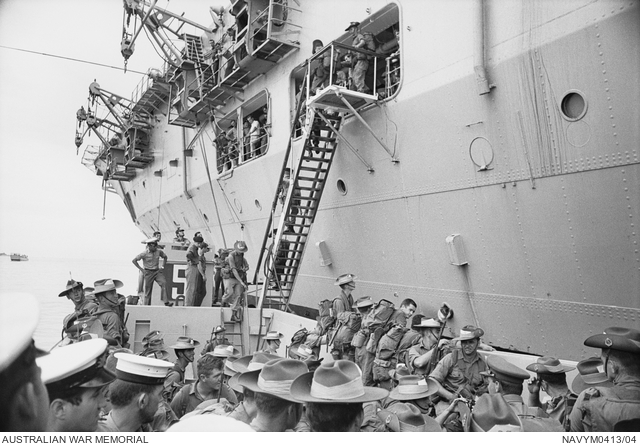
8th RAR dismembarked onto landing crafts.
-Her 17th (21 October-12 November) with HMAS Vendetta and 2 RAR, 8 RAR embarked. In February 1971, she visited Hobart as flagship for the Royal Hobart Regatta.
-Her 18th started in Adelaide, ambarking 3 RAR (15 February-2 March) with HMAS Yarra, returning with 7 RAR and the ashes of Rear Admiral Harold Farncomb scattered underway.
-In July 1971 she went to the US, collecting ten A-4G Skyhawks for the Fleet Air Arm and Melbourne. That’s the only time she saw jets on her flight deck. They were craned down, not flown of course.
-Her 19th voyage started also from Adelaide (26 March-? April) with cargo and foreign aid supplies for the Khmer Republic, escorted by HMAS Duchess. She had some recreational leave in Hong Kong before departing to Australia.[
-The 20th voyage from Townsville (13 May-1 June) and back was with 4 RAR, escorted by HMAS Duchess and Parramatta, carrying back 2 RAR.
-In July 1971 she however departed to Esquimalt in British Columbia for Canada’s centennial naval assembly. She cruised to San Diego, collecting ten new A-4G Skyhawk for Melbourne and was back in Austrlian by mid-August.
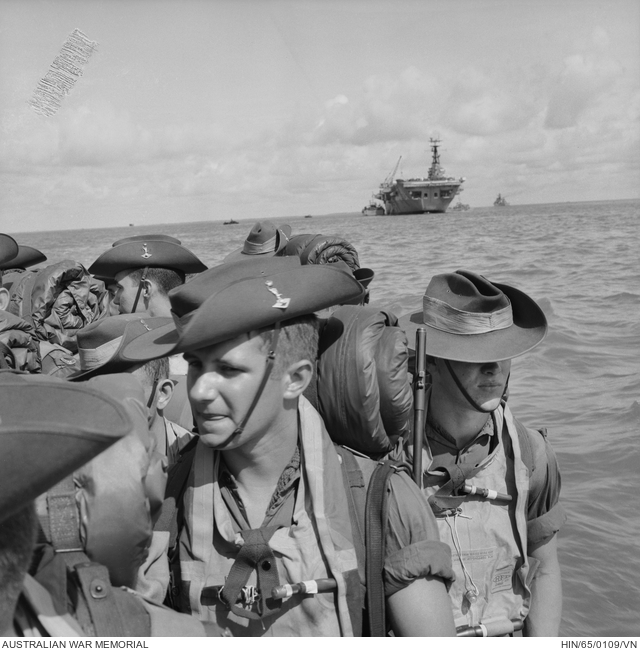
Signallers comes ashore from HMAS Sydney
-Her 21th (20 September-16 October) HMAS Sydney was to Singapore with the ANZUK force, escorted by HMAS Swan and 3 RAR, heli-lifted to her deck bore departing. Sydney for return to Australia, with the troopship arriving in Adelaide on 16 October.
-Her 22th (23 October-22? November) voyage show her carrying a cargo of Defence Aid stores, escorted by HMAS Derwent and came back with Australian personnel and equipment
-Her 23th (24 November-17 Dec.) voyage had her empty, escorted by HMAS Swan off Subic Bay and embarking 4 RAR, 104th Battalion, Royal Australian Artillery, No.9 Squadron, visited by President Nguyễn Văn Thiệu before departing. She arrived at Townsville on 17 December.
-Her 24th (14 February-9 Marcg 1972) trip saw her escorted by HMAS Torrens to recuperate 457 Australian soldiers from various units and she was back in Townsville.
Three days later she was back in Sydney, to close the RAN invovement in the Vietnam War. A refit followed (22 May-20 October).
-25th voyage (1st Nov.-?) she carried defence equipment and foreign aid supplies for South Vietnam and the Khmer Republic, escorted by HMAS Vampire, still in Vũng Tàu and came back with misc. Australian equipment, assisting en route the disabled merchant ship Kaiwing, towing her for repairs in Hong Kong. This was her last trip. Back home it was time for a report and statistics:
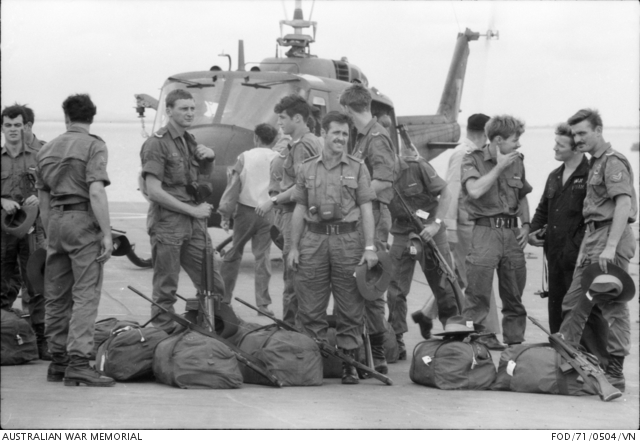
3rd RAR soliders awaits helicopters on deck, start of withdrawal, October 1971
They showed she transported 16,902 soldiers, 5,753 tons of cargo, 2,375 vehicles, 14 aircraft. There were no awards at the time, albeit later in 1986, the Government created a “Returned from Active Service” Badge for all these personnel, enabling military service pensions, followed by the “Vietnam Logistic and Support Medal” in 1992. A battle honour for her transportation service was confirmed in March 2010.
Decommission and Disposal (1973-75)
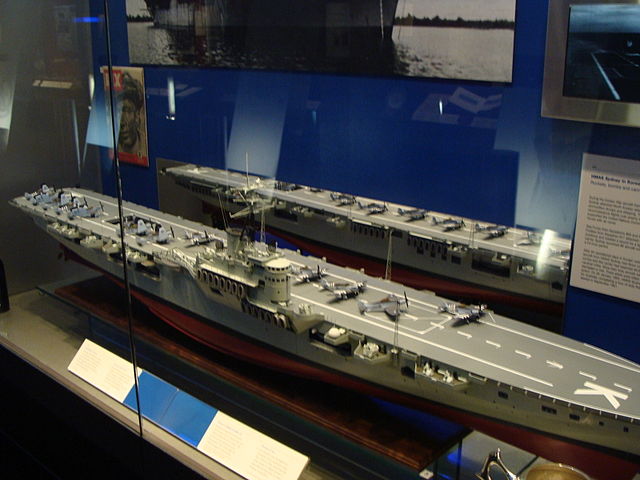
Maritime Museum Model
In 1973, the carrier was given her last pennant, L134, marked for another deployment to Mururoa atoll, supporting a RNZN frigate protesting French nuclear testing there. The former carrier was able to replenish a small fleet, and was selected as replacement when HMAS Supply was undergoing refits. However the Australian government delayed to not pushed futher tensions, and the oiler was refitted when a decision could be made anyway, so Sydney was not deployed, the oiler went instead. Sydney made another cruise to Singapore in March 1973 and back to Australia, the, she was off New Zealand in April for training exercises and another joint warfare exercise in Jervis Bay by May 1973.
On 20 July 1973, decommission was decided by the Government. The planned refit was cancelled. On 12 November 1973 she was paid off, maked for disposal after logging some 711,549 nautical miles (1,317,789 km; 818,836 mi) total in her two careers. The Geelong Regional Tourist Authority at the time suggested she could be turned as a museum at Corio Bay, doubling as a convention centre and floating casino, while the Naval History Society of Australia wanted to save at least the island superstructure, send on the Rocks maritime museum. The Sydney Opera House proposed to turn her as floating car park, after splitting her hangar in two storeys. On 7 October 1975 none had the finances for their project and she was sold for BU on 30 October to Dongkuk Steel Mill, Seoul, for A$673,516 (best bid). She was towed by a Japanese tugboat from 23 December 1975 and scrapping started upon arrival.
Her replacement, planned already in the 1960s, had speculations from the press, of an Iwo Jima class vessel or HMS Hermes be purchased. Instead the latter was considered to replace onstead HMAS Melbourne. The Australian Defence Force however lacked a long-range troop transportation ship and had to wait for the Round Table-class HMAS Tobruk, commissioned in 1981. HMAS Sydney’s chapel and bell are now at HMAS Moreton base from 1974n then in the Australian National Maritime Museum, anchors and propeleller are also in display, the first at the FAA Museum (HMAS Albatross). The name was given next to FFG 03, an Adelaide-class guided missile frigate (launched 1980, decomm. 2015) and now is carried by DDG 42, an AEGIS capable Hobart-class destroyer (2020).

 Latest Facebook Entry -
Latest Facebook Entry -  X(Tweeter) Naval Encyclopedia's deck archive
X(Tweeter) Naval Encyclopedia's deck archive Instagram (@navalencyc)
Instagram (@navalencyc)





 French Navy
French Navy Royal Navy
Royal Navy Russian Navy
Russian Navy Armada Espanola
Armada Espanola Austrian Navy
Austrian Navy K.u.K. Kriegsmarine
K.u.K. Kriegsmarine Dansk Marine
Dansk Marine Nautiko Hellenon
Nautiko Hellenon Koninklije Marine 1870
Koninklije Marine 1870 Marinha do Brasil
Marinha do Brasil Osmanlı Donanması
Osmanlı Donanması Marina Do Peru
Marina Do Peru Marinha do Portugal
Marinha do Portugal Regia Marina 1870
Regia Marina 1870 Nihhon Kaigun 1870
Nihhon Kaigun 1870 Preußische Marine 1870
Preußische Marine 1870 Russkiy Flot 1870
Russkiy Flot 1870 Svenska marinen
Svenska marinen Søværnet
Søværnet Union Navy
Union Navy Confederate Navy
Confederate Navy Armada de Argentina
Armada de Argentina Imperial Chinese Navy
Imperial Chinese Navy Marinha do Portugal
Marinha do Portugal Mexico
Mexico Kaiserliche Marine
Kaiserliche Marine 1898 US Navy
1898 US Navy Sovietskiy Flot
Sovietskiy Flot Royal Canadian Navy
Royal Canadian Navy Royal Australian Navy
Royal Australian Navy RNZN Fleet
RNZN Fleet Chinese Navy 1937
Chinese Navy 1937 Kriegsmarine
Kriegsmarine Chilean Navy
Chilean Navy Danish Navy
Danish Navy Finnish Navy
Finnish Navy Hellenic Navy
Hellenic Navy Polish Navy
Polish Navy Romanian Navy
Romanian Navy Turkish Navy
Turkish Navy Royal Yugoslav Navy
Royal Yugoslav Navy Royal Thai Navy
Royal Thai Navy Minor Navies
Minor Navies Albania
Albania Austria
Austria Belgium
Belgium Columbia
Columbia Costa Rica
Costa Rica Cuba
Cuba Czechoslovakia
Czechoslovakia Dominican Republic
Dominican Republic Haiti
Haiti Hungary
Hungary Honduras
Honduras Estonia
Estonia Iceland
Iceland Eire
Eire Equador
Equador Iran
Iran Iraq
Iraq Latvia
Latvia Liberia
Liberia Lithuania
Lithuania Mandchukuo
Mandchukuo Morocco
Morocco Nicaragua
Nicaragua Persia
Persia San Salvador
San Salvador Sarawak
Sarawak Uruguay
Uruguay Venezuela
Venezuela Zanzibar
Zanzibar Warsaw Pact Navies
Warsaw Pact Navies Bulgaria
Bulgaria Hungary
Hungary

 Bundesmarine
Bundesmarine Dutch Navy
Dutch Navy Hellenic Navy
Hellenic Navy Marina Militare
Marina Militare Yugoslav Navy
Yugoslav Navy Chinese Navy
Chinese Navy Indian Navy
Indian Navy Indonesian Navy
Indonesian Navy JMSDF
JMSDF North Korean Navy
North Korean Navy Pakistani Navy
Pakistani Navy Philippines Navy
Philippines Navy ROKN
ROKN Rep. of Singapore Navy
Rep. of Singapore Navy Taiwanese Navy
Taiwanese Navy IDF Navy
IDF Navy Saudi Navy
Saudi Navy Royal New Zealand Navy
Royal New Zealand Navy Egyptian Navy
Egyptian Navy South African Navy
South African Navy






























 Ukrainian Navy
Ukrainian Navy dbodesign
dbodesign